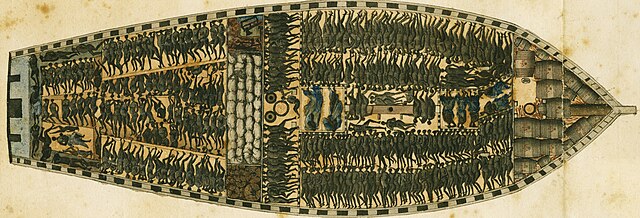Top Qs
Timeline
Chat
Perspective
Thomas Parr (slave trader)
English slave trader From Wikipedia, the free encyclopedia
Remove ads
Thomas Parr (1769–1847) was a member of an extended family of Liverpool merchants, developing his business as an English slave trader who profited from the Atlantic slave trade[2] to establish himself as "‘a merchant of great eminence in Liverpool".[3]

Career
Thomas Parr was born on 4 November 1769, the son of John Parr, gunmaker of Frederick Street, Liverpool, by his wife Hannah Anderton.
In subsequent years, he invested in at least 30 slave voyages. One of the slave ships that he had built for the trade in enslaved people, Parr, exploded on her maiden voyage. A street in Liverpool where he built a warehouse is named after him.
Slave trade


Parr invested in at least 30 slave voyages,[4] and was sole owner of several ships:
Remove ads
Personal life

Parr built a house at Colquitt Street in Liverpool in 1797, that has been described as "magnificent".[13] The south wing of the house was a counting house. The house is flanked by pavilions, with one of them being used as a coach house. There was also a courtyard, a pleasure garden, a pond, and walks. The house was used between 1817 and 1948 as Liverpool Royal Institution; many of the people that established the institution were former slave traders.[13]

Behind the house he built a warehouse that he used to store iron goods that were traded for slaves. The warehouse was five storeys high with a basement, with seven window bays to the south elevation and three to the east and west, each bay with ashlar lintels and stone sills. A passage led from the warehouse to the counting house.[13]
Retirement
Parr sold his Liverpool home around 1805 and retired to a country house and estate called Lythwood Hall, near Bayston Hill in Shropshire.[14] He became part of the landed gentry and acquired a notable collection of rare coins.[15] The acclaimed evolutionary scientist Charles Darwin met him in 1840, and described him as "an old, miserly squire".[13][16]
Legacy
Parr Street in Liverpool is named after him. Both his former home on Colquitt Street, Liverpool and his warehouse on Parr Street are listed with Historic England.[13][17] His former home at Lythwood Hall in Shropshire was demolished but there is a memorial to him in Lythwood.[18]
References
Wikiwand - on
Seamless Wikipedia browsing. On steroids.
Remove ads
